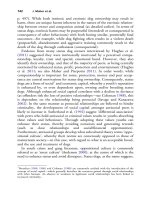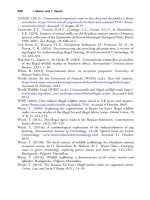The palgrave international handbook of a 264
Bạn đang xem bản rút gọn của tài liệu. Xem và tải ngay bản đầy đủ của tài liệu tại đây (37.45 KB, 1 trang )
260
R. White
Air, land and water are directly affected by the extraction (mining) and
processing (smelting) of mined substances. So, too, the world’s climate is
being altered by the emission of greenhouse gases to which mining is a major
contributor. Recent developments, such as mega-mines and coal-seam fracking will exacerbate these harms due to the scale and nature of the methods
used. It is notable in this regard that scientists are now reporting the wide
scale movement of many species towards the world’s poles due to a warming
climate. It has also been observed that changes in sea temperatures are
impacting upon fish and kelp habitat, and that bird migration patterns and
breeding grounds are being disrupted and/or changing as a result of changing
climatic parameters (Macaulay 2016).
This section has briefly reviewed how the pollution of air, land and water
habitats is creating harm to nonhuman animals. Pollution has direct effects,
as in the case of catchment run-off draining into the sea and the prevalence of
plastics in the ocean. It also has indirect effects, as evidenced in how carbon
emissions, the main contributor to accelerated global warming, eventually
translates into fundamental transformations of habitat. For fish in the sea,
birds in the air, and bears on the ice, the ramifications are profound.
Preservation and Conservation of Habitat
Responding to the issues identified in this chapter is not as straightforward as
may first appear. Specific responses might include introduction and better
enforcement of environmental laws that prevent land clearing, stricter controls on or abolition of polluting industries (especially those most contributing to carbon emissions), and banning of the planting of GM crops. These
strategies depend entirely upon the balance of political forces at the local
through to the international levels. There are other factors and dilemmas that
impinge upon the question of how best to respond to habitat destruction and
subsequent harm to animals as well.
The reverence for and privileging of nonhuman nature sometimes translates
into a concern for the ‘righteous management’ of nature, and manifests in an
agenda that advocates for the mass preservation of wilderness, protection of
endangered nonhuman species and restoration of disturbed areas towards a
pristine nature or pristine condition (Devalleand Sessions 1985). There are two
immediate problems with this view. First, it implies a separation of humanity
and nature as if this was and always has, empirically, been the case. The notion
of ‘pristine nature’ implies precisely this kind of rigid separation, yet historical
and cross-cultural study indicates exactly the opposite—namely, constant and









